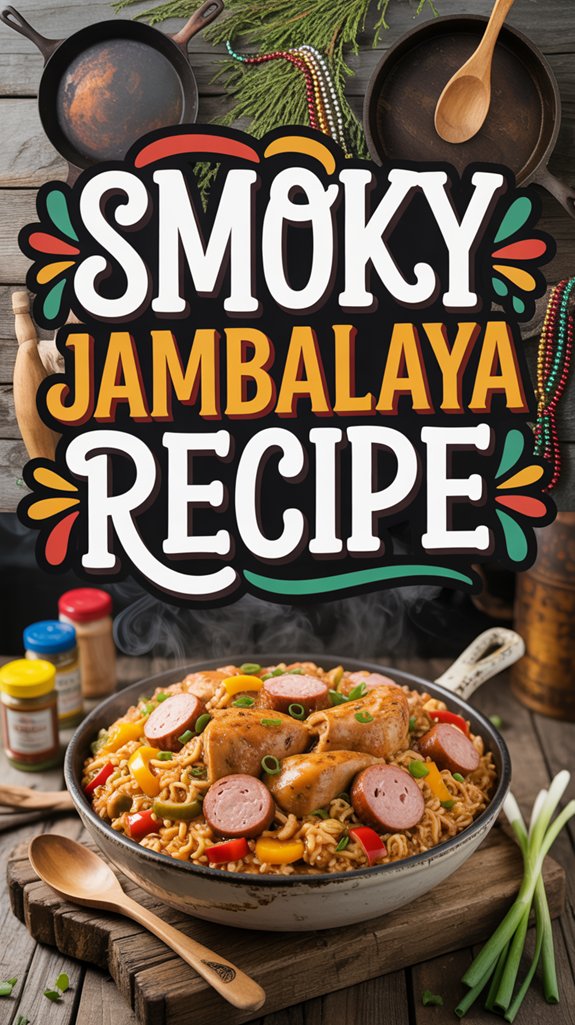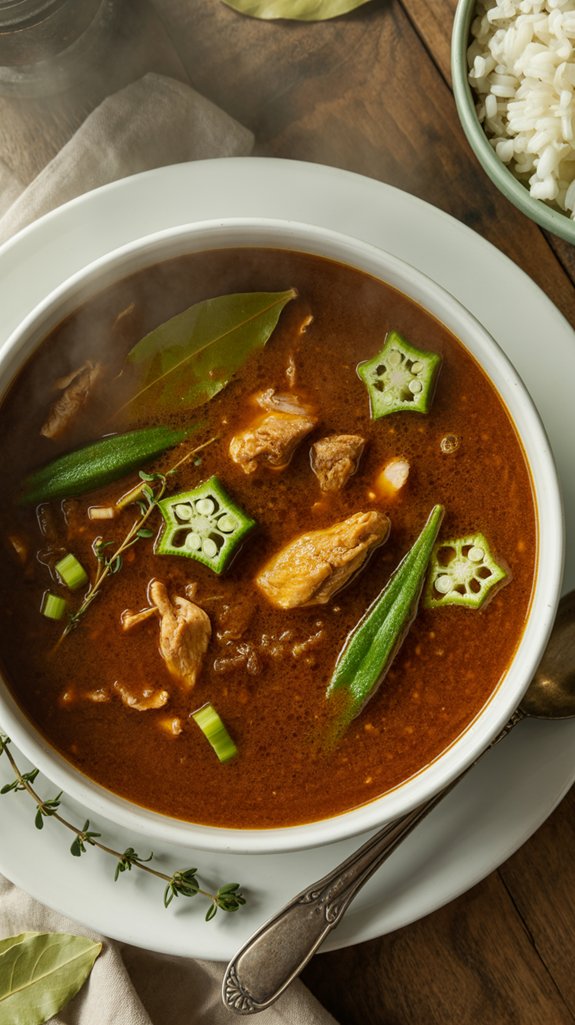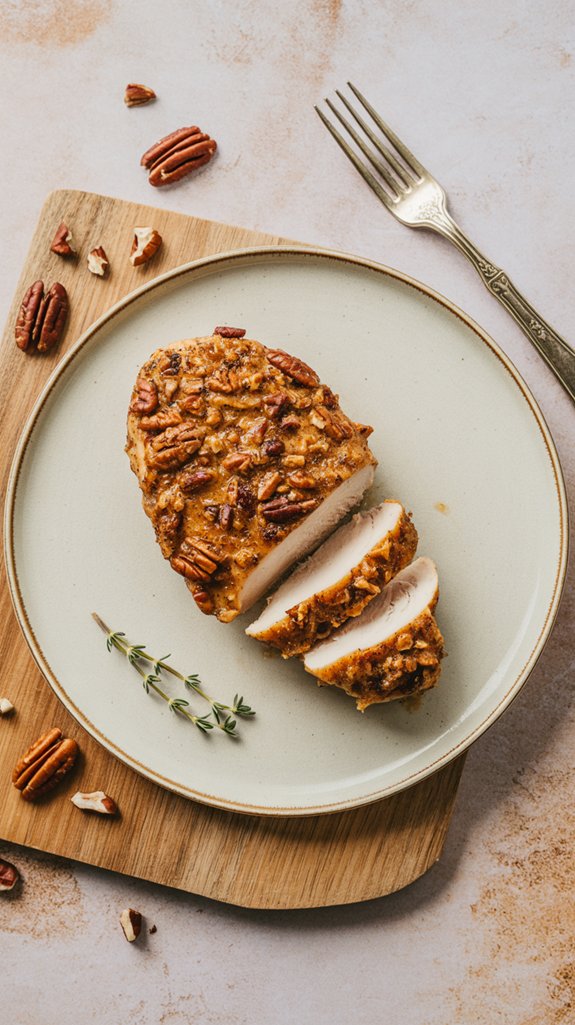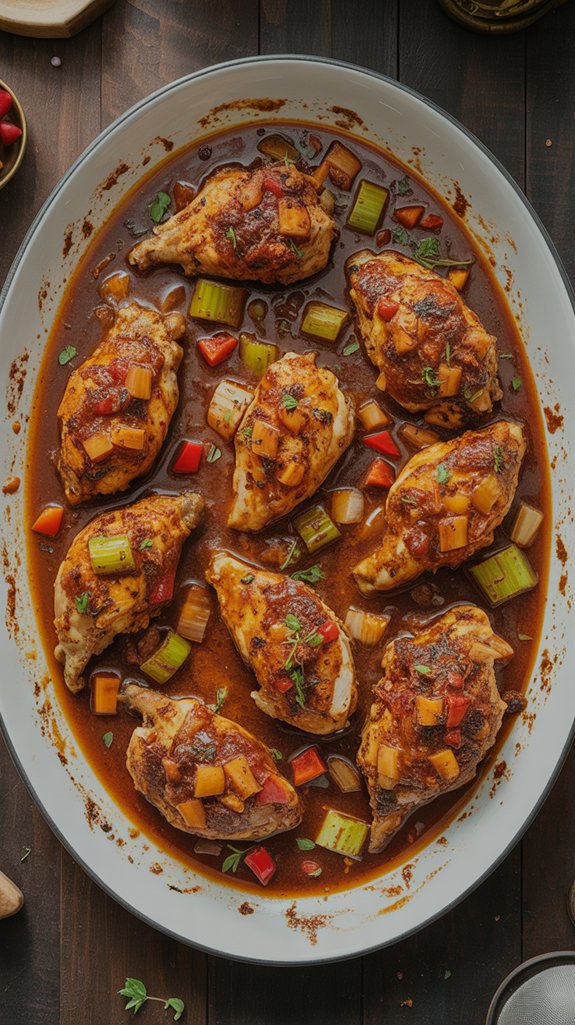Why You’ll Love This this Smoky Louisiana Chicken & Sausage Jambalaya
This jambalaya brings together tender, fall-apart chicken and smoky sausage in a rich, spicy base that’ll make your kitchen smell like the best Louisiana restaurant you’ve ever been to.
The secret is in that dark roux and the holy trinity of onions, bell peppers, and celery, which creates a flavor foundation so good you might find yourself sneaking spoonfuls straight from the pot.
Plus, you get to serve the chicken on the side, so everyone can grab their favorite pieces without having to dig through the rice like they’re on some kind of treasure hunt.
Ingredients List
Let me break down everything you’ll need to create this soul-warming Louisiana masterpiece that’ll have your neighbors mysteriously finding excuses to drop by around dinnertime.
- 4 lbs fryer chickens, cut in small serving pieces
- 1 1/2 tablespoons salt
- 3 teaspoons cayenne pepper
- 2 teaspoons black pepper, freshly ground
- 2 teaspoons white pepper
- 1 lb pork sausage, smoked, sliced 1/2 inch thick
- 2 large yellow onions, chopped fine
- 2 medium bell peppers, chopped fine
- 3 celery ribs, chopped fine
- 2 teaspoons fresh basil, chopped (or 1/2 tsp dried)
- 5 tablespoons dark roux
- 1 pint chicken stock
- 6 ounces Tabasco sauce
- 2 cups raw rice
- 1 cup green onion, chopped
- 1 cup parsley, chopped
A few things worth noting about these ingredients:
- This recipe packs serious heat with three different peppers and a hefty dose of Tabasco, so maybe keep some milk handy if you’re not used to Louisiana-level spice
- The smoked sausage adds great flavor but also brings along plenty of sodium and fat, which pairs with the already rich dark roux
- Fresh herbs like basil, green onions, and parsley do add nutritional value and bright flavors that help balance out all that indulgent richness
- You can lighten things up slightly by removing the skin from the chicken pieces, though you’ll lose some of that traditional flavor
Step by Step Directions
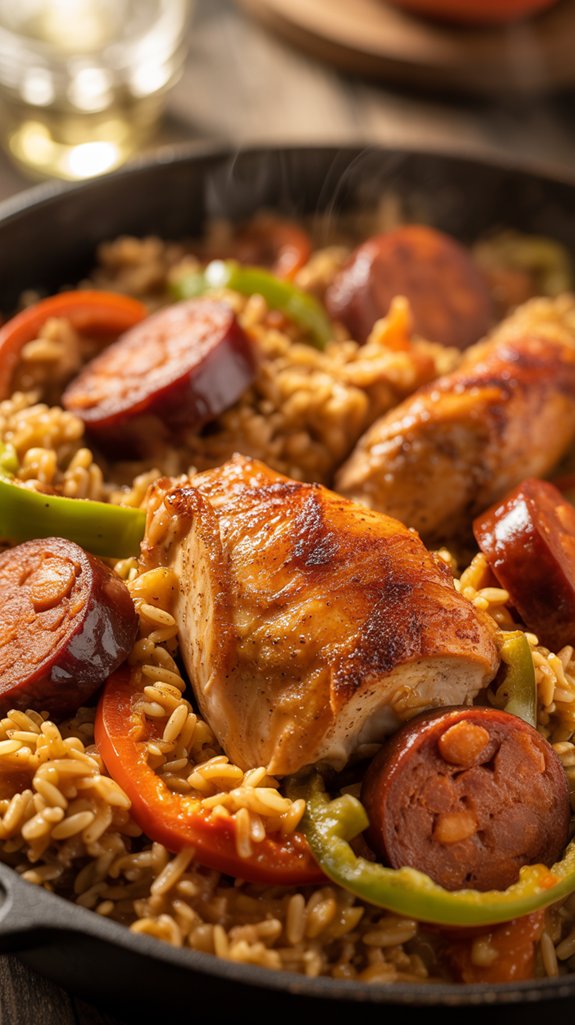
Master this traditional Louisiana jambalaya by following these essential steps that build layers of flavor from the ground up.
- Prepare the chicken: Cut fryer chickens into small serving pieces, then mix salt, cayenne, black pepper, and white pepper in a bowl and season chicken with half the mixture.
- Brown the proteins: Heat Dutch oven over medium heat, brown sliced smoked sausage on all sides and remove, then brown seasoned chicken pieces and remove.
- Build the base: Pour off excess fat, reduce heat, and sauté chopped onions, bell peppers, and celery for 20 minutes, stirring occasionally.
- Add seasonings: Stir in fresh basil and remaining salt-pepper mixture, cook for a few minutes more.
- Incorporate roux: Add dark roux and cook until heated through, then slowly add chicken stock until mixture reaches consistency thicker than gumbo but thinner than stew.
- Develop flavors: Stir in Tabasco sauce and simmer slowly for 20 minutes, stirring often.
- Cook proteins: Return sausage and chicken to pot, cover, and cook over low heat for 45 minutes to 1 hour until chicken is very tender, stirring occasionally.
- Prepare rice: Steam rice separately while chicken cooks.
- Combine and finish: Remove chicken to serving platter, transfer rice to large bowl, gradually mix in jambalaya base to desired consistency, then fold in chopped green onions and parsley.
- Serve: Plate rice mixture with chicken pieces alongside, or bone chicken and mix directly into jambalaya base before serving.
For the best results when cooking this authentic jambalaya, consider using Mediterranean cookware sets that provide excellent heat distribution and retention throughout the long cooking process.
Substitutions and Variations
- Roux shortcuts – Store-bought dark roux saves time and won’t burn on you like homemade can, but if you’re feeling ambitious, making your own gives you bragging rights and tastes slightly better.
- Herb variations – Fresh thyme instead of basil works wonderfully, and a bay leaf or two in the simmering stage adds depth.
Just don’t forget to fish them out before serving unless you enjoy watching someone bite into a surprise.
Additional Things to Serve With This Dish
This jambalaya is rich and filling, but a few simple sides will round out your Louisiana feast perfectly.
- Cornbread or crusty French bread – You’ll want something to soak up every last drop of that flavorful base, and honestly, licking the plate is frowned upon in most social circles.
- Simple green salad – A basic mix of lettuce, tomatoes, and cucumber with vinaigrette cuts through all that smoky richness and makes you feel slightly virtuous.
- Coleslaw – The cool, crisp texture provides a nice contrast, plus it’s practically a vegetable serving, which counts for something.
- Pickled okra or dill pickles – The tangy bite cleanses your palate between bites, and they’re traditional in Louisiana for good reason.
- Sweet tea or cold beer – Because spicy food demands a cold drink, and arguing with tradition seems foolish.
- Vanilla ice cream – Trust me on this one, a small scoop after all that heat is like a cool breeze on a sweltering day.
Cooking Tips & Tricks (Chef’s Notes)
After making countless batches of jambalaya, I’ve learned that a few simple tricks can turn good jambalaya into the kind that makes people ask for your recipe in hushed, reverent tones.
- Don’t rush the browning – Those golden bits stuck to the bottom of your pot aren’t mistakes, they’re flavor gold, so let that chicken and sausage get properly caramelized before moving on.
- Taste your roux before adding it – If it tastes burnt or bitter, start over because no amount of seasoning will fix a scorched roux, and life’s too short for disappointing jambalaya.
- Keep your heat low and steady – Jambalaya is like a good friendship, it needs time and patience to develop properly, so resist the urge to crank up the heat.
- Stir gently and infrequently – Once you add the rice, treat it like it’s sleeping, because too much stirring will turn your beautiful grains into mushy disappointment.
- Let it rest off the heat – After cooking, give it 10 minutes to settle and absorb any remaining liquid, which is when the magic really happens.
- Make extra jambalaya base – Seriously, this stuff freezes beautifully and having it on hand means you’re always 20 minutes away from a satisfying meal.
- Adjust liquid gradually – You can always add more stock, but you can’t take it back, so go slow and trust your instincts about consistency.
Nutritional Facts
This hearty Louisiana classic packs substantial nutrition along with its bold flavors, serving 6-8 people generously.
Per Serving (based on 8 servings):
- Calories: 485-520 calories per serving
- Protein: 28-32 grams (excellent source from chicken and sausage)
- Carbohydrates: 38-42 grams (primarily from rice)
- Fat: 22-26 grams (varies by sausage type and chicken skin)
- Fiber: 2-3 grams (from vegetables and rice)
- Sodium: 950-1,100mg (significant due to sausage, seasonings, and Tabasco)
- Iron: 15-18% daily value (from chicken and fortified rice)
- Vitamin C: 45-55mg (bell peppers are the star here)
- Vitamin A: 8-12% daily value (from colorful vegetables)
- Calcium: 4-6% daily value
- Potassium: 420-480mg (chicken and vegetables contribute)
- Cholesterol: 85-95mg (from chicken and sausage)
- Saturated Fat: 7-9 grams
Nutritional Highlights:
- High-quality complete protein from chicken
- Complex carbohydrates for sustained energy
- Vitamin C boost from bell peppers and celery
- B-vitamins from chicken and fortified rice
- Antioxidants from herbs and colorful vegetables
Fun “Did You Know?”
Did you know that authentic jambalaya never actually mixes the rice directly with the other ingredients during cooking?
I’ve learned that traditional Louisiana cooks prepare the jambalaya base separately, then combine it with steamed rice afterward. This technique prevents mushy rice and allows you to control the consistency perfectly.
Another fascinating fact: there’s an ongoing rivalry between Creole and Cajun jambalaya styles. Creole versions include tomatoes, while Cajun varieties don’t.
The word “jambalaya” likely comes from the French “jambon” meaning ham, though today’s versions often feature chicken and sausage like our smoky recipe here.


